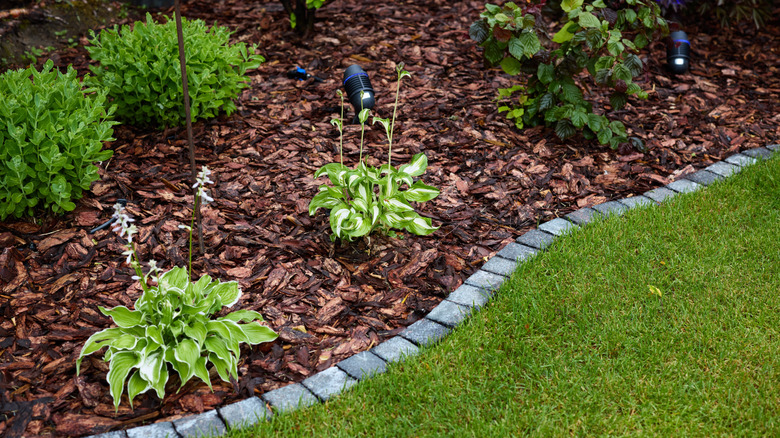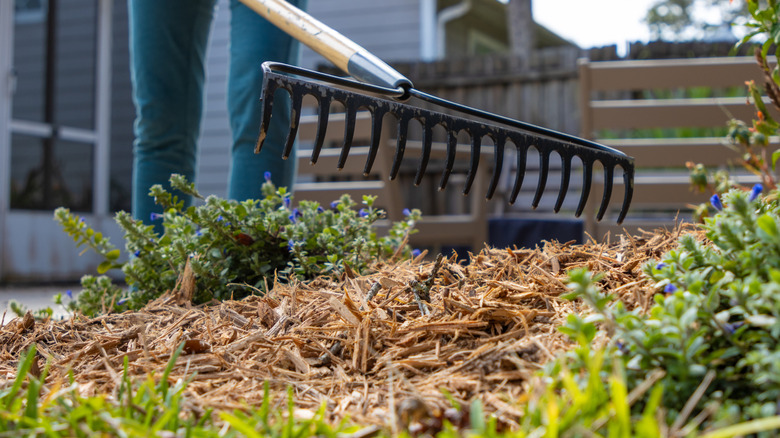Skipping One Crucial Step When Laying Mulch Could Cause Your Garden To Suffer
How many times have you heard that you should mulch your gardens and landscaped areas? A trip to the gardening section of any home improvement store means you'll see tons of mulch options, all ready to refresh your landscape. But do you really know how to apply mulch well? There are many common mulching mistakes that people make as they try to improve the health of their garden. One of those mistakes is tossing new mulch on top of an old layer without raking or prepping the ground in any way. That's a quick way to compact the material and create a matted mess that keeps the plant roots from getting the nutrients they need.
One of the perks of using organic mulch is that it breaks down over time and adds nutrients to your soil. How quickly it breaks down depends on the type of mulch and the conditions. Larger pieces of mulch like bark typically take longer to decompose than smaller pieces like wood chips. You can expect a layer of mulch to completely break down in four to seven years. As it breaks down, it needs to be replaced if you want to maintain the benefits.
However, you might also replace mulch more often to freshen up the look of the garden and replenish the lower layers as they decompose. Mulch also fades over the months or years, especially in sunny areas. Whatever the case, avoid the temptation to simply toss a fresh layer on top without doing the groundwork first.
Old mulch can become matted
So what do you do when you want to add more mulch? The good news is you don't need to remove the old mulch before adding a fresh layer unless it's moldy or infested with pests. That can happen to your garden if you use too much mulch originally. Removing the old material in those situations lets you start fresh with the correct amount of organic material.
If your existing mulch is still good, you can leave it in the garden and add more on top — but not before you rake or cultivate it. As the mulch decomposes, it tends to clump and mat together, particularly if you use shredded hardwood mulch. Matting can be particularly bad in hot summer weather when it dries out and sticks together. Fungi can make the matting worse.
That knitted layer of old mulch often keeps water and sunlight from penetrating the dense material. If you have plants growing in the area, they won't receive the essential nutrients they need to thrive. Matted mulch could also promote fungal growth and mold. If you simply pile new mulch on top of a matted layer, the area looks fresh and new, but the plants still suffer from a lack of nutrients. This is why it's important to prepare the old layer properly.
Rake or cultivate the mulch first
Grab a rake or cultivator to resolve the problem. Raking the mulch helps loosen the pieces and break up the clumps before adding a new layer. A potato hoe also works well for breaking up clumps of organic material. Stay shallow around plants to avoid digging so deeply that you damage the roots. Even if you're not adding new mulch, it's a good idea to rake or turn your mulch between seasons to prevent matting.
If you grab a handful of the old mulch and it's mostly decomposed into a soil-like texture, using a cultivator to work it into the soil is a good way to prepare for new material. When the mulch is mostly gone, it no longer provides the protective benefits like preventing weed growth, controlling soil temperatures, and reducing erosion. However, it still adds nutrients to the soil when you till it into the garden.
Then, you can add the new layer of mulch to the appropriate thickness. To determine the amount of mulch you need for your garden, consider what you're planting and how much usable mulch is left. You typically need between 2 and 3 inches of mulch, so add enough to reach that ideal depth. For instance, if you still have 1 inch of good mulch left, add another 1 to 2 inches after you rake the area.


